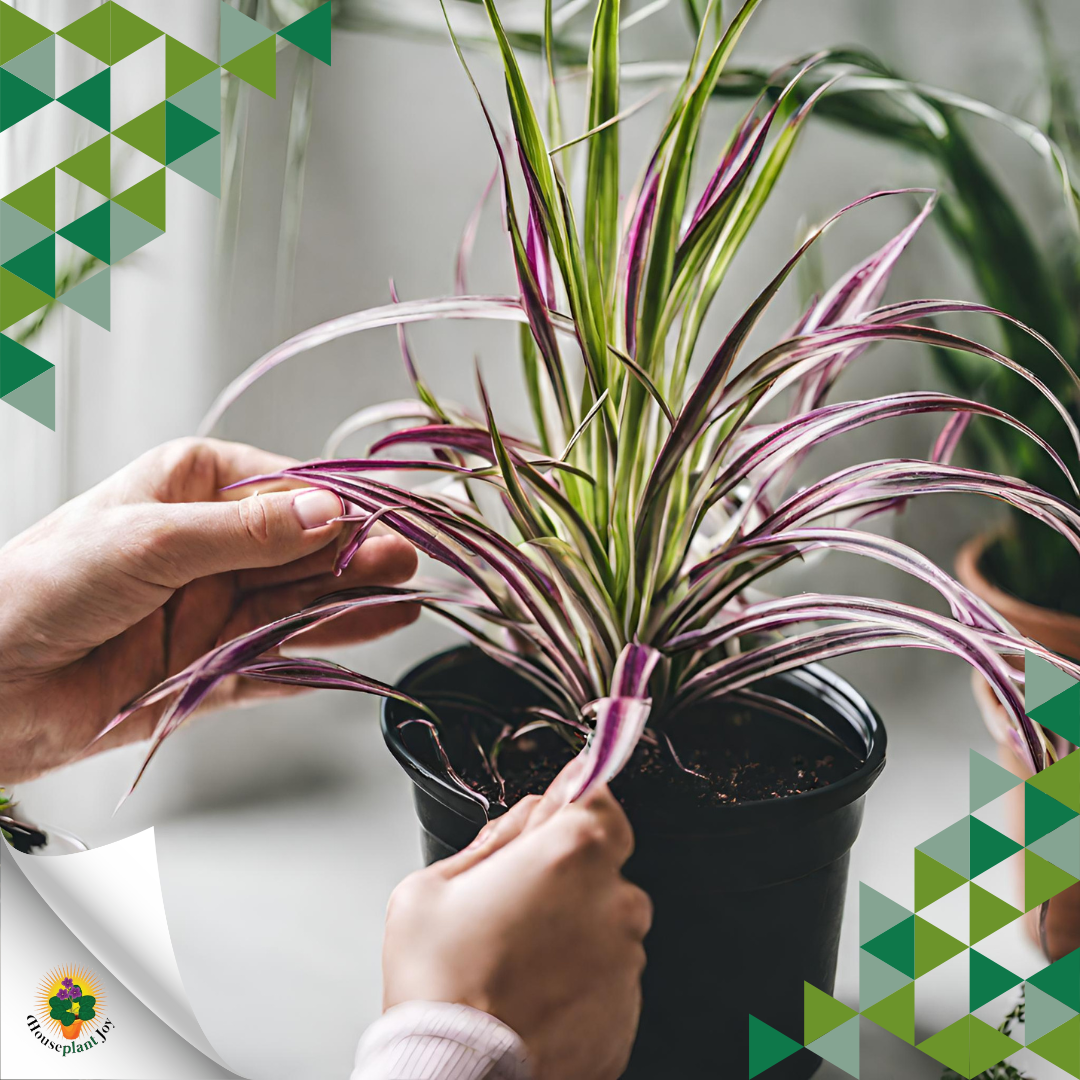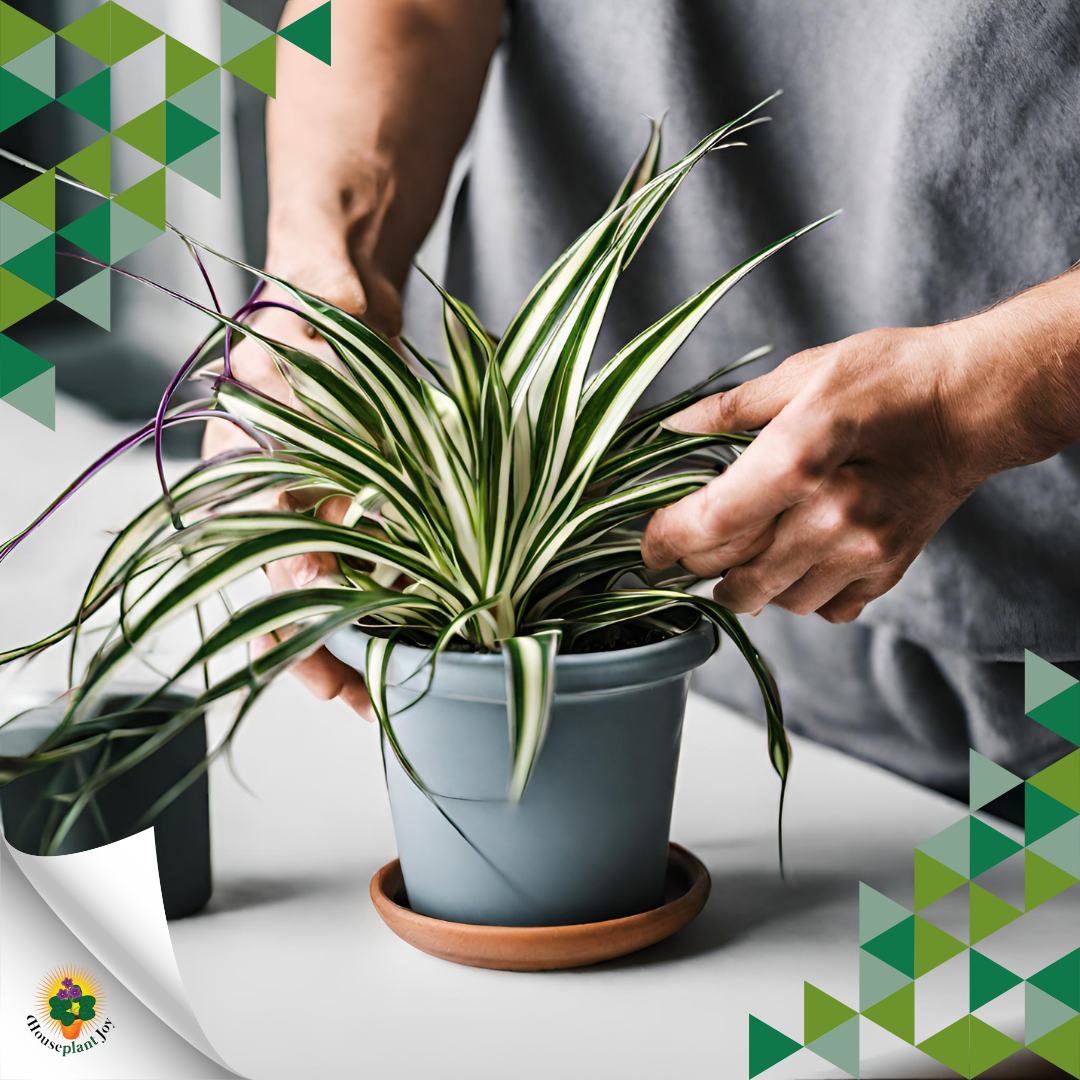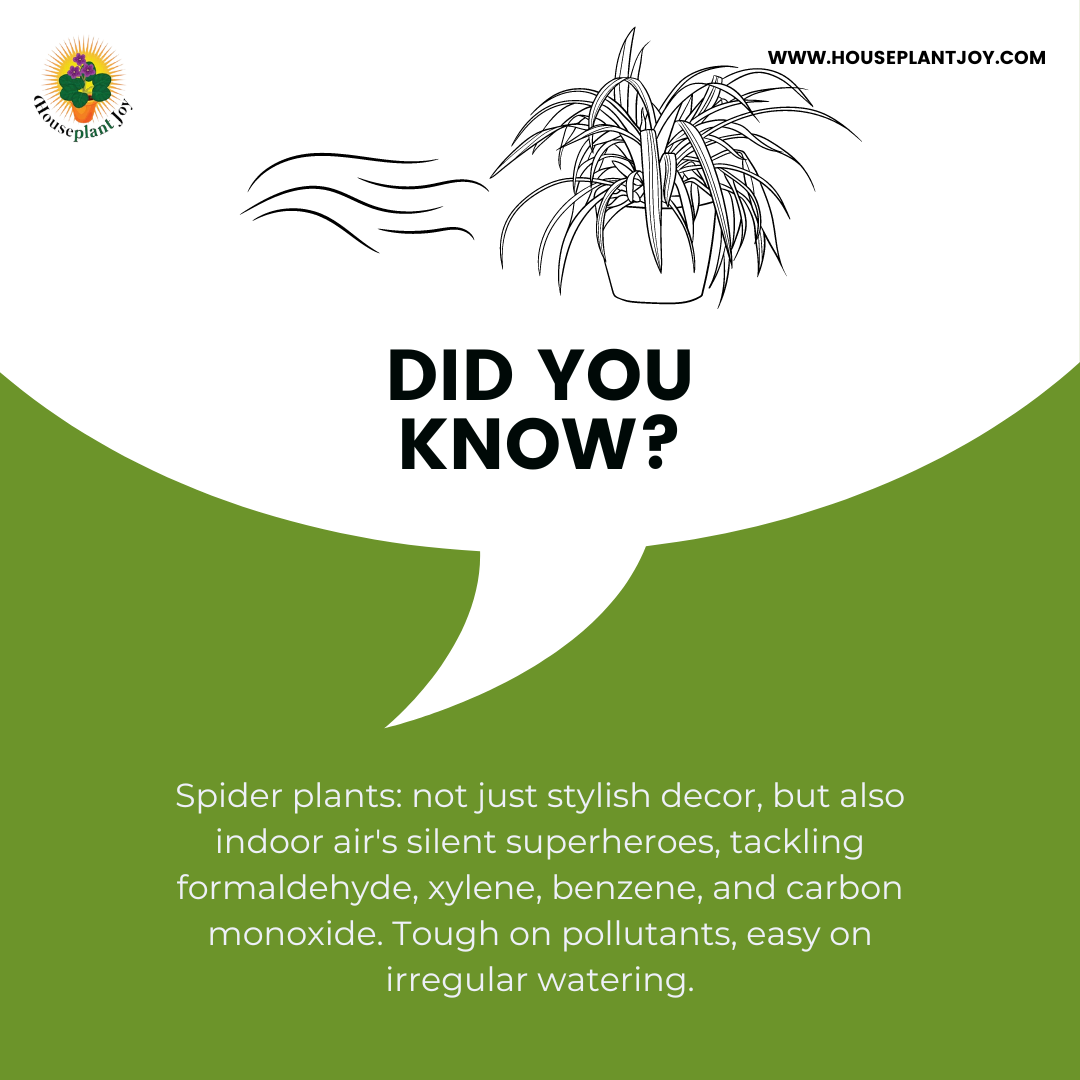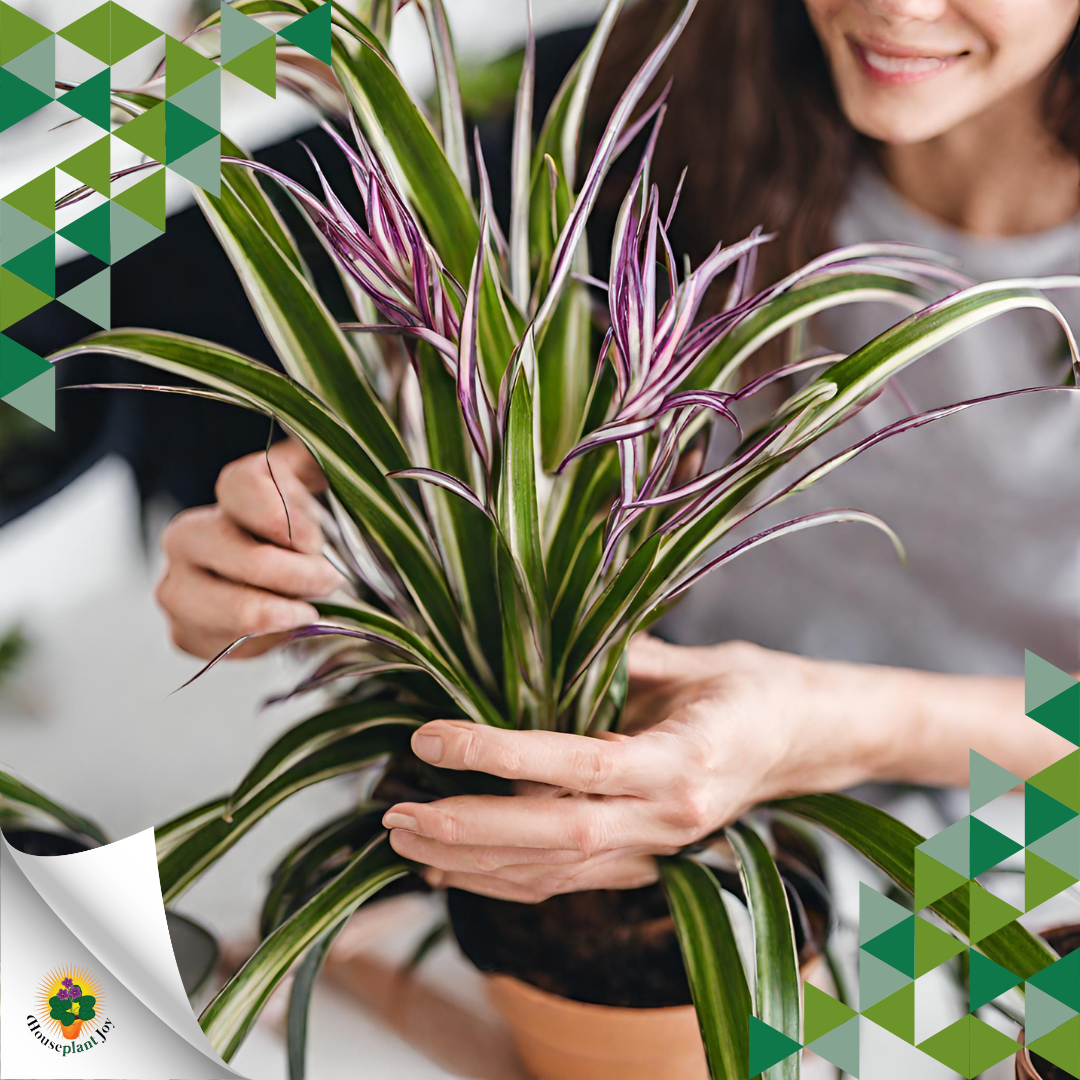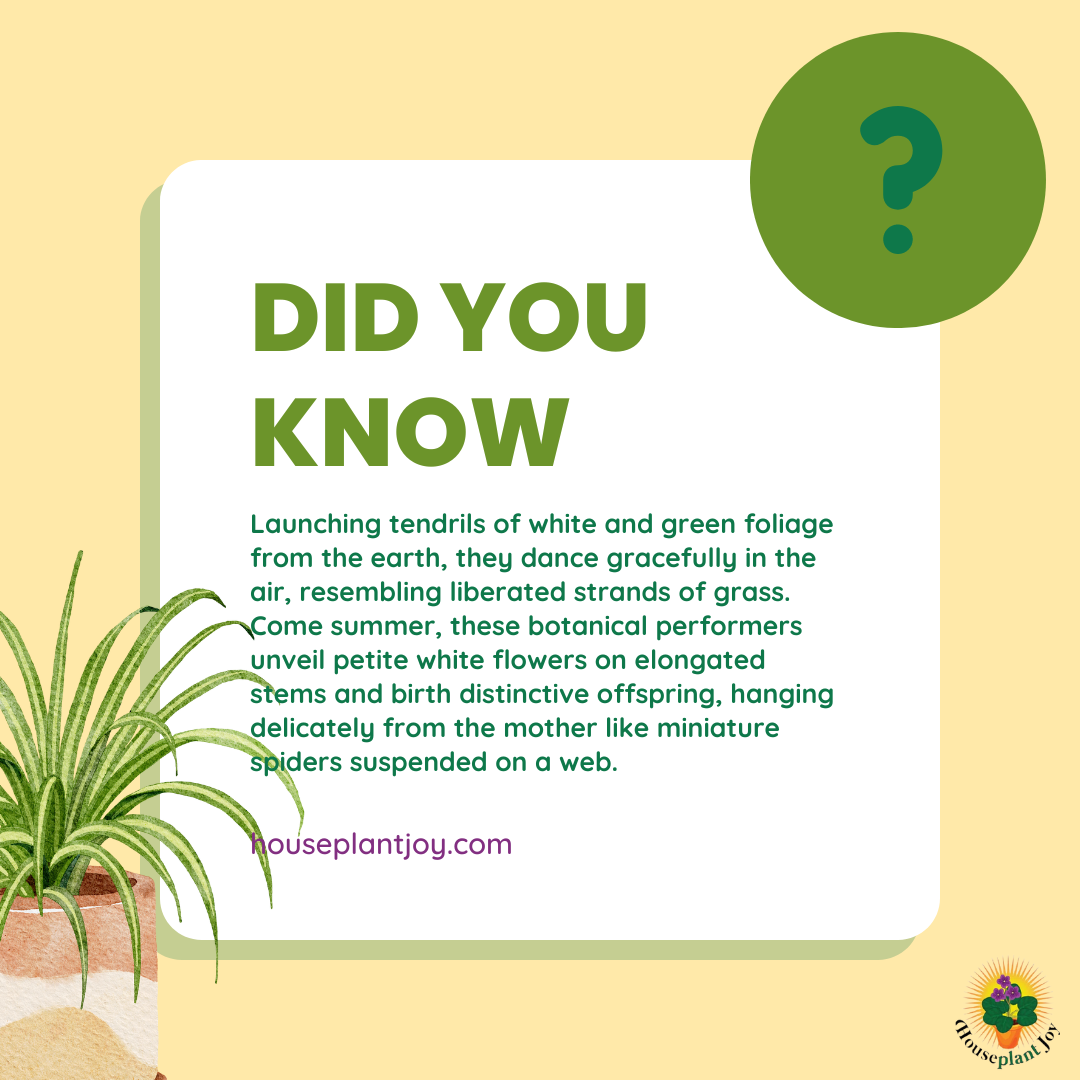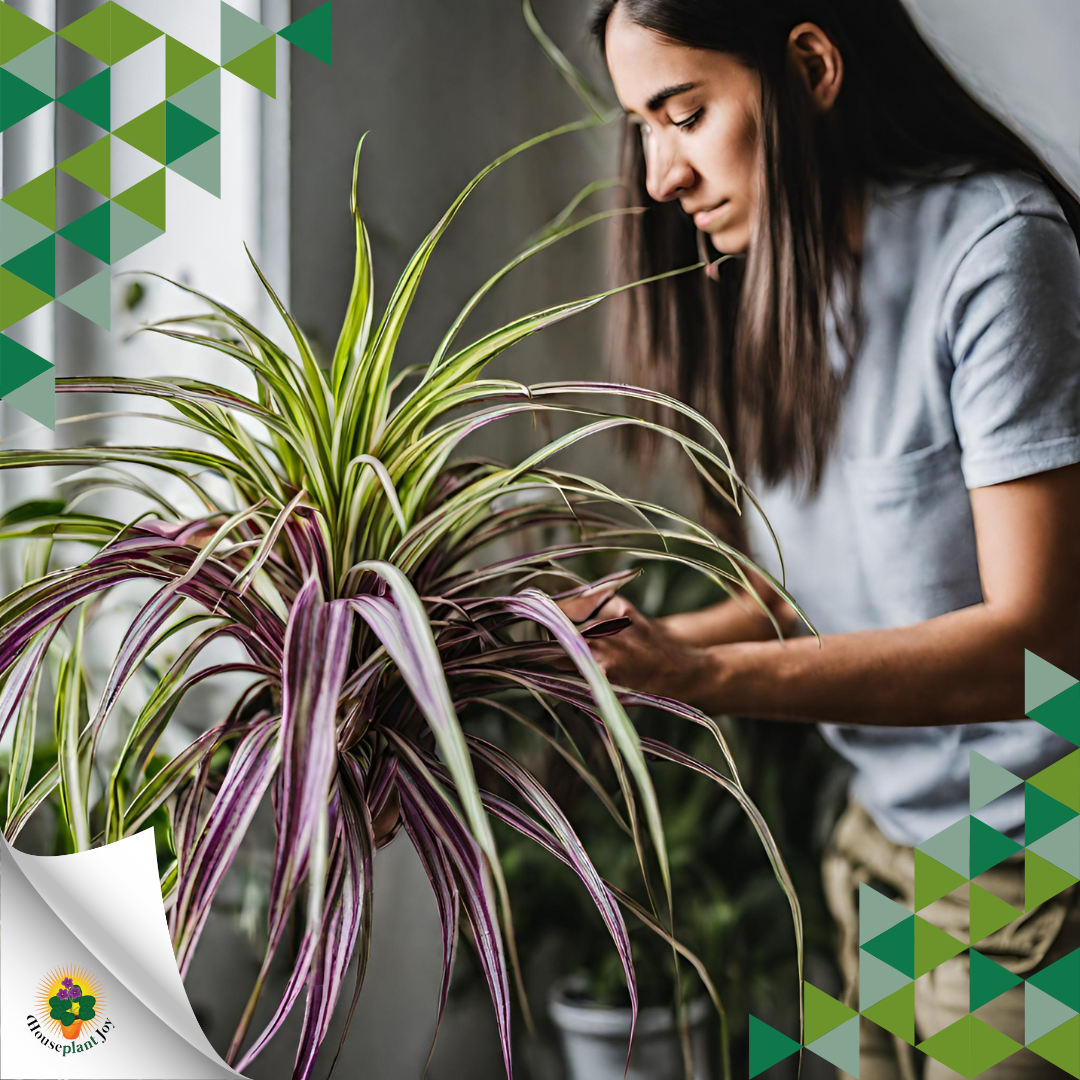HousePlantJoy is supported by our audience. When you purchase through one of our links, we may earn a small affiliate commission. As an Amazon Associate I earn from qualifying purchases. Your cost is not affected.
==================
Purple Spider Plant is an exceptional and attention-grabbing houseplant that can elevate the aesthetics of any indoor space with its deep purple foliage and intricate spider-like appearance. However, taking care of the Purple Spider Plant demands specific attention and understanding. If you’re in search of a distinctive and captivating addition to your home, the Purple Spider Plant is an excellent choice.
Purple Spider Plant Care: Exploring Characteristics, Propagation, Troubleshooting, and Home Benefits
In this guide, we will explore the characteristics of this plant, its care requirements, propagation methods, common issue and solution, as well as the benefits of having a Purple Spider Plant at home. So let’s dive in and uncover the secrets to successful Purple Spider Plant care.
Everything You Need To Know About the Purple Spider Plant
Before we delve into the care requirements, let’s take a moment to understand the Purple Spider Plant, also known as Tradescantia pallida. This plant is characterized by its deep purple foliage, which is the standout feature that sets it apart from other varieties or clusters of spider plant. The foliage is long and slender, resembling spider legs, hence the plant’s name.
This plant grows up to 12 inches in height, and they produce small, inconspicuous pink or white flowers during early summer. With their unique appearance and easy care, Purple Spider Plants have become a popular choice for houseplant enthusiasts.
Characteristics of the Purple Spider Plant
The foliage of the Purple Spider Plant is what makes it truly captivating. With its deep purple color, the leaves add a touch of drama and elegance to any room. The long, slender shape of the foliage resembles spider legs, giving the plant its distinctive look. The Purple Spider Plant can reach a height of up to 12 inches, making it a versatile option for both smaller and larger spaces. While the foliage is the main attraction, it’s worth noting that this plant also produces small, inconspicuous pink or white flowers during early summer. These blooms may not be the plant’s main feature, but they add a delicate touch and enhance its overall beauty.
The Purple Spider Plant, also known as Tradescantia pallida, is a drought-tolerant plant that thrives in full sun to light shade. This means it can adapt to a wide range of light conditions, making it suitable for various indoor environments. Additionally, Purple Spider Plants are low maintenance, making them an ideal choice for beginners or those with a busy lifestyle. Their spider-like appearance, combined with their low maintenance nature, has made them a favorite among houseplant enthusiasts.
Origin and Distribution
The Purple Spider Plant, scientifically known as Tradescantia pallida, is native to the Gulf Coast region but can also be found in other tropical and subtropical regions around the world. It is a resilient and fast-growing plant, which has contributed to its widespread distribution.
Purple Spider Plants are known for their ability to adapt to different environments, making them suitable for a variety of garden settings. Whether planted indoors or outdoor landscape, these perennials are sure to grow and thrive which will bring a touch of elegance to any space.
Essential Care Requirements for Purple Spider Plant
Now that we’ve covered the basics, let’s dive into the suppose care requirements for the Purple Spider Plant.
Light Requirements
It thrives in a light-filled environment, so it’s essential to provide them with adequate light. Ideally, they prefer full sun to light shade, but they can also tolerate a few hours of direct afternoon sun. Placing your plant near a window or in a well-lit area will ensure it receives the light it needs to flourish. Lack of sufficient light can result in leggy growth and loss of the plant’s characteristic color. Keep in mind that the intensity and duration of sunlight may vary depending on your specific location, so it’s essential to assess the light conditions in your home and adjust accordingly.
Watering Needs
When it comes to watering your Purple Spider Plant, it’s important to strike the right balance. They are drought-tolerant once established, meaning they can withstand periods of dryness. However, they still require periodic watering to thrive.
As a general rule, water your plant when the top inch of soil feels dry to the touch. This ensures that the plant receives adequate moisture without being overwatered. Overwatering can lead to root rot, so it’s crucial to avoid letting the plant sit in standing water. During the winter months, reduce watering to prevent waterlogged soil and related issues.
Soil Preferences
Choosing the right soil for your Purple Spider Plant is essential for its overall health and growth. These plants thrive in well-draining soil, as excessive moisture can lead to root rot. A lightweight potting mix that contains perlite is ideal, as it promotes healthy root growth and allows water to drain freely.
The Purple Spider Plant is adaptable to various soil types, but it prefers slightly acidic soil. You can create a suitable soil mix by combining peat, pine bark, and perlite, ensuring a good balance of nutrients and drainage. Avoid using heavy, compacted soils, as they hinder drainage and may lead to root issues.
Temperature and Humidity Conditions
Purple Spider Plants thrive in warm temperatures, making them well-suited for indoor environments. The ideal temperature range for these grown plants is between 60°F to 75°F (15°C to 24°C). It’s important to protect the plant from frost and cold drafts, as they can be detrimental to its health. Adequate humidity is also crucial for the Purple Spider Plant, especially in dry indoor environments.
Aim for a humidity level between 40% to 60%, and consider misting the plant occasionally to create a humid microclimate. Avoid exposing the plant to sudden temperature fluctuations, as they can negatively impact its overall well-being.
Propagation Methods for Purple Spider Plant
Now that you know how to care for your Purple Spider Plant, you may want to propagate it and share its beauty with others. Thankfully, there are a few different methods for propagating Purple Spider Plants. These methods are relatively simple and can be done by plant enthusiasts of all levels of experience.
Propagation through Cuttings
Propagation through stem cuttings for new growth is one of the easiest and most reliable ways to propagate Purple Spider Plants. To do this, choose a healthy stem with at least 2-3 nodes, as these nodes are essential for root formation. Cut the stem just below a leaf node, and remove any lower leaves. Place the cutting in a glass of water or a well-draining potting mix, ensuring that at least one node is submerged.
Keep the cutting in a warm, humid environment with indirect light, and mist it regularly to maintain moisture. Once the cutting has developed a healthy root system, you can transplant it into a suitable pot or garden bed during early summer.
Propagation through Division
Another method of propagating Purple Spider Plants is through division. This involves separating the plantlets, also known as offsets, from the parent plant and planting them individually. Division is often done during repotting, as it allows for easier access to the plant’s root system. Gently remove the plant from its container, taking care not to damage the roots.
Identify the plantlets, which are miniature versions of the parent plant, and carefully separate them using your hands or a clean, sharp tool. Plant each division in a separate container, ensuring they have adequate moisture, light, and nutrients to encourage growth. Division is a straightforward and effective way to multiply your Purple Spider Plant collection.
Common Issues and Solutions in Purple Spider Plant Care
Even with proper care, Purple Spider Plants may occasionally encounter issues. Understanding these common problems and their solutions can help ensure the health and vitality of your plant. By being attentive and proactive, you can address these issues promptly and help your plant thrive.
Overwatering and Root Rot
One of the most common issues faced by Purple Spider Plants is overwatering, which can lead to root rot. Overwatered plants may exhibit symptoms such as wilting, yellowing leaves, and a foul odor. To prevent overwatering, ensure that the soil is well-draining, and allow it to dry out slightly between waterings.
Avoid letting the plant sit in standing water, as this can suffocate the roots and lead to root rot. Adjusting your watering schedule to reflect the plant’s needs and environmental conditions can help combat overwatering and keep your Purple Spider Plant healthy.
Pest Infestations
Like many houseplants, Purple Spider Plants are susceptible to pest infestations, including spider mites, aphids, and mealybugs. Regularly inspecting the plant for pests is crucial, as early detection can prevent infestations from escalating. If you notice any signs of pests, such as webbing, sticky residue, or visible insects, take immediate action.
Natural remedies like neem oil are effective in combating spider plant pests. Isolating an infested plant and treating it promptly can minimize the spread of pests to other plants. Practicing integrated pest management techniques, such as regular cleaning and monitoring, can help control pest populations and maintain the health of your Purple Spider Plant.
Leaf Browning or Yellowing
Leaf browning or yellowing can be indicators of underlying issues in Purple Spider Plants. Excessive sunlight, low humidity levels, underwatering, or nutrient deficiencies may all fall to leaf discoloration. To prevent leaf browning, ensure that your plant is receiving the right amount of light for its specific needs. If your plant is exposed to intense sunlight, consider adjusting its placement or providing shade during the hottest part of the day.
Additionally, maintaining proper humidity levels by misting the plant or using a humidifier can help prevent leaf browning or yellowing. Regularly monitor your plant’s watering needs, as underwatering can also lead to leaf discoloration. Providing the right environmental conditions will promote vibrant foliage in your Purple Spider Plant.
Benefits of Having a Purple Spider Plant at Home
In addition to its striking appearance, the Purple Spider Plant offers several benefits that make it a great addition to any indoor space.
Air Purification Abilities
Spider plants, including the Purple Spider Plant, have been shown to be effective in purifying indoor air. They have the ability to remove harmful toxins like formaldehyde, which can be found in common household products, from the air. The foliage of spider plants acts as a natural air filter, reducing airborne pollutants and creating a healthier living environment. Incorporating Purple Spider Plants into your indoor spaces can help improve air quality and promote well-being. By utilizing these plants for air purification, you can contribute to a more sustainable and eco-friendly lifestyle.
Easy Maintenance for Beginners
Purple Spider Plants are known for their low maintenance nature, making them perfect for beginners or those with a busy lifestyle. These plants require minimal watering, as they are drought-tolerant once established. Additionally, they are adaptable to a wide range of light conditions, making them suitable for various indoor environments. With their resilience and forgiving nature, Purple Spider Plants are a great way to introduce greenery into your home without the added stress of demanding care routines. Whether you’re new to plant care or simply looking for an easy-to-maintain houseplant, the Purple Spider Plant is an excellent choice.
Tips for Displaying Your Purple Spider Plant
Now that you’ve mastered the care requirements for your Purple Spider Plant, it’s time to think about how to display it in your home. By choosing the right location and considering companion plants, you can create a stunning display that showcases the beauty of the Purple Spider Plant.
Ideal Locations for Placement
Purple Spider Plants thrive in bright, indirect light, so it’s important to choose an ideal location for their placement. Place your plant near a window or in a well-lit area where it can receive ample light without being exposed to direct sunlight for extended periods of time. It’s also important to ensure adequate airflow around the plant, as this prevents moisture-related issues. Select locations with consistent temperatures and light conditions to provide optimal conditions for your Purple Spider Plant. By carefully choosing the placement of your plant, you can ensure its overall well-being and enhance its visual appeal.
Companion Plants for Purple Spider Plant
Companion plants for the Purple Spider Plant include petunias, which complement the foliage with their vibrant colors. Tradescantia is also a great companion due to similar light requirements. Consider adding early summer blooming perennials and low-maintenance options like sedum for an easy-care garden bed.
Video Credits: @onlyplants
Purple Spider Plant: A Fusion of Purple Flowers and Leaves
The purple spider plant is a beautiful addition to any indoor space. Its unique characteristics and air purification abilities make it a popular choice among plant enthusiasts. By providing the right care, such as proper lighting, watering, and soil conditions, you can ensure the health and vibrancy of your purple spider plant. Remember to watch out for common issues like overwatering and pest infestations, and take appropriate measures to address them.
With its easy maintenance and beginner-friendly nature, the purple spider plant is an ideal choice for those new to plant care. Display it in ideal locations and consider companion plants to enhance its beauty. Enjoy the benefits of having a purple spider plant at home and create a green oasis that brings joy and freshness to your living space.
Frequently Asked Questions
What Are the Ideal Growing Conditions for a Purple Spider Plant?
Purple spider plants thrive in bright, indirect sunlight and well-draining, moist soil. They prefer temperatures between 60°F to 75°F and should be watered carefully to avoid overwatering. Fertilize every 2-3 months during the growing season for optimal growth.
How Often Should I Water My Purple Spider Plant?
To keep your purple spider plant healthy, water it once a week or when the top inch of soil feels dry. Avoid overwatering to prevent root rot. These plants prefer well-draining soil and moderate humidity levels. If the leaves start turning brown or drooping, adjust the watering frequency accordingly.
What Are Some Common Pests or Diseases That Can Affect a Purple Spider Plant?
Common pests and diseases that can affect purple spider plants include spider mites, which cause yellowing leaves and webbing. Mealybugs can also infest the plant, leaving a sticky residue. Overwatering can lead to root rot and fungal diseases, resulting in wilting and discoloration of foliage. Regular inspection and prompt treatment are key to maintaining a healthy purple spider plant.
How Can I Propagate a Purple Spider Plant?
Propagating a purple spider plant is a simple process with various methods. One way is to take stem cuttings with two leaves and root them in water or soil. Another method is dividing the plant at the root ball and planting each division separately. Provide adequate moisture, light, and nutrients for growth.
Stay In the Loop: Follow Us on Social Media for Trendy Insights
Follow our social media channels to embark on a journey of exclusive content, behind-the-scenes glimpses, and vibrant community engagement. Stay in the loop with the latest updates, trends, and inspiration that we curate just for you.
Click that ‘Follow’ button now and immerse yourself in a world of shared passions, creativity, and discovery!
Related Readings


